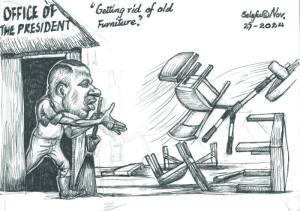We are fresh from a weeklong Botswana-France collaboration tour of the Pyrenees Mountains. The Pyrenees is a rich natural and cultural landscape and a 500 kilometre-long mountain range straddling the boundaries of France with Spain.
Our Botswana team of five engaged a lot with the hosts, comprising, as we did, the director who doubles as a museum exhibition designer, a guide based at the Gcwihaba Caves, a geologist, a landscape archaeologist as well as a Motswana palaeontology doctoral student.
The surprise checking of the team by the Botswana Ambassador to France and UNESCO, Mustaq Moorad gave the tour a diplomatic twik and a blessing. We could not ask for more acclaimed but kind hosts than the duo of Toulouse University Professor Laurent Bruxelles and Toulouse Museum director Francis Duranthon.
In particular, Bruxelles is the celebrated French geo-archaeologist who in 2014 led a multi-disciplinary team that disentangled the long standing paleontological dating puzzle at South Africa’s Sterkfontein ‘cradle of mankind’.
Until he worked here, Australian palaeontologists had dated the Australopithecine fossil named ’Little Foot’ to 2.5 million years basing on a dating of the cave flow stones and that was for decades erroneously accepted in the scientific community.
The 2.5 million dating was a headache in the study of human origins as it failed to explain similarity in form of South African hominid fossil record with the much earlier dates of their counterpart fossil sites in East Africa. Bruxelles’ painstaking study on the cave formation process and the dating of the more reliable morpho-sedimentary contexts extended the dating of Little Foot to 3.7 million years.
With the legendary Bruxelles as the trip organizer, we were destined for an epic rendezvous. The expedition took us to the caves of Mas d’Azil, Pech Merle, Niaux and Bedeilhac, all either within or about the margins of the Pyrenees Mountains.
Unlike Botswana and southern Africa where rock art is found outside caves in outdoor rock faces, rock shelters and overhangs such as at Tsodilo, conversely, French and European prehistoric rock paintings are almost all found deep within caves. Some of the Caves such as Mas D’Azil may have limited or no speleothems - those mineral deposits left in caves by the action of water.
However, Mas D’Azil is immensely rich in archaeological deposits that demonstrate successive human occupation from the Palaeolithic, through to the Magdalenian, the Bronze Age and, even more recently, World War 2 occupation.
It will be erroneous to argue as to whether it is Pech Merle Cave or Niaux Cave that has the most amazing rock art because they are both a phenomenon. Both sites have large silhouette like paintings of various animals dominated by the Bison. Both sites are a geomorphological marvel that offers long undulating trails beneath the surface of the earth.
The stalagmites and stalactite at Pech Merle Caves left the most enduring memory and, so too, the pearls that form deep underground due to the action of water on the parent rock over several millennia. Yet Niaux Cave takes the ultimate price for its cave lake, the floor engravings and the majestic rotunda with its acoustics that may have attracted prehistoric painters and possible ritual practices. No doubt the ‘Black Chamber’ section of Niaux Cave was an icing in the cake for me, excitingly presented with many surprises by archaeologist and community guide, Audrey Laffont. The chamber has numerous geometric and animal paintings from the Bison, mountain goat, horses and reindeer.
The Niaux Cave’s Black Chamber was made popular by Breuil who also studied Namibian rock art of the Brandberg Mountains. He also infamously mislabelled but popularised the “White Lady of the Brandberg”. As ethno archaeologists came to correct him, the supposed white lady painting was, in fact, a medicine man in full regalia but whose curvilinear features and erosions at key points could give impression that the white painting was female.
It is also at Niaux Cave that I thought of Xontae Xhao of Tsodilo and how he presents as scenic, the Tsodilo male Hill panel 15 on Rhino Trail. The thought was provoked by the persistent refusal of archaeologist Laffont to see the black chamber panels of Niaux as a possible scene, despite the depictions of numerous animals in action on the same panel.
Typical of French scientific approach to rock paintings, the panels won’t be assumed to be a scene until they are first individually dated and proven to be contemporaneous. Besides, argues Laffont, the prehistoric painters at Niaux Cave evidently entered the cave at different times due to the known geological evolution of the cave and evidence that some rock paintings were actually super imposed on previous ones. Yet, so what? Who says subsequent and successive painters could not add a story to an existing scene? With an annual patronage of 30,000 visitors, Niaux Cave enjoys the old tradition of visiting caves by the French population. Unfortunately, such visits since the 18th century have left hundreds of graffiti that, in comparison, make our Tsodilo Hills and Gcwihaba Caves look impeccable.
Until today, Tsodilo’s 12,000 annual visitors marvel at the community’s belief system and restrictions that have gifted humanity with an impeccable World Heritage Site in the North Western Corner of Ngamiland. Once again, the French populations who defaced the rock art could have learnt from Jun/hoasi and Hambukushu ancestors.
*Phillip Segadika is chief curator at the Botswana National Museum. Interpretations do not necessarily reflect those of the department. The broader research collaboration project is sponsored by the CNRS (French National Centre for Scientific Research), The French Ministry For Europe and Foreign Affairs, The Toulouse Museum and the Botswana government.








